E-commerce statistics for individuals
Data extracted in February 2023.
Planned article update: February 2025.
Highlights
In 2023, 92% of the surveyed individuals used internet and 69% bought or ordered products or services online in the 12 months preceding the survey.
E-commerce in the EU was boosted by the demand of the age groups 25-34 years and 35-44 years in 2023. 87% and 84% of individuals in these age groups, respectively, bought or ordered goods or services online in 2023.
In 2023, 57% of e-shoppers had no or low formal education background, 75% had medium formal education and 88% had high formal education background.
44% of e-shoppers bought or ordered 'Clothes, shoes and accessories', the item mostly bought or ordered online in 2023.
Internet users who bought or ordered goods or services for private use in the previous 12 months by age group, EU, 2010-2023
This article presents the results of e-commerce in 2023, a topic of the annual ICT (information and communication technology) survey on the use of information technology by households and individuals in the European Union (EU). E-commerce is defined as the purchase of goods or services over the internet (e-commerce, e-shopping) for private use via any device (desktop, portable, tablet computer, mobile phone) from enterprises (e.g. stores, travel agencies) and private individuals. Purchases refer to ordering goods or services for which payment is required, but the payment does not have to be done online.
The characteristics of e-commerce in the EU are presented in this article. What were the main age groups feeding e-commerce in 2023? How has this demand by age class evolved over the last 10 years? The Covid-19 pandemic boosted e-commerce - has the demand for e-commerce in 2023 exceeded the demand boosted by the Covid-19 lockdowns? How did the level of income and education impact the demand? What was the frequency of purchases reported by the e-shoppers in 2023? What was the share of domestic compared with cross-border markets (the market of other EU countries, market of the rest of the world)? What were the most popular products bought by e-shoppers in 2023? What was the size of the collaborative economy in 2023? These questions are answered in this article.
The benefits of e-commerce are well known: access to a very wide range of products (domestic and cross-border markets), easier price comparison, shopping in the comfort of your home, access to other consumers' views on the products covered, etc. These different benefits continued to boost e-commerce in 2023. On the other side, the improvement of the general health situation followed by a return to in-person shopping has constrained the growth of online shopping in 2023.
Full article
Main points
- In the EU in 2023, among all the individuals aged 16-74 years surveyed, 92 % used the internet within the last 12 months in 2023 while 69 % bought or ordered goods or services, an increase of 1 percentage point (pp) compared with 2022.
- Looking at internet users, 75 % bought or ordered goods online in the EU in 2023
- A generational divide between e-shoppers
- Higher level of e-commerce was correlated with higher level of education and employment status in 2023
- Clothes and deliveries from restaurants on top of the online purchases in 2023
- Frequency of the purchases: Most often 'Once or twice' and 'three to five times'
- Origin of the sellers: 53 % of the purchases made from national sellers in 2023
- 42 % of the e-buyers reported no issue while purchasing online compared with 21 % encountering problems
69 % of EU citizens aged 16-74 years bought or ordered goods or services online in 2023
In the EU, while 92 % of the individuals aged 16-74 years used the internet within the last 12 months, 69 % bought or ordered goods or services in 2023, an increase of 1 pp compared with 2022. The gap between those who used the internet and those who bought or ordered goods or service was 23 pp in the EU as a whole, this gap was below the double digit in the Netherlands (7 %) and Sweden (9 %), peaking to 35 % in Cyprus, 37 % in Italy and 39 % in Bulgaria. In Norway, the gap between internet users and e-buyers was 9 % and 16 % in Switzerland in 2023. The proportion of e-shoppers was particularly low in Montenegro (29 %) compared with the internet users leading to a gap of 61 pp between the two figures in 2023.
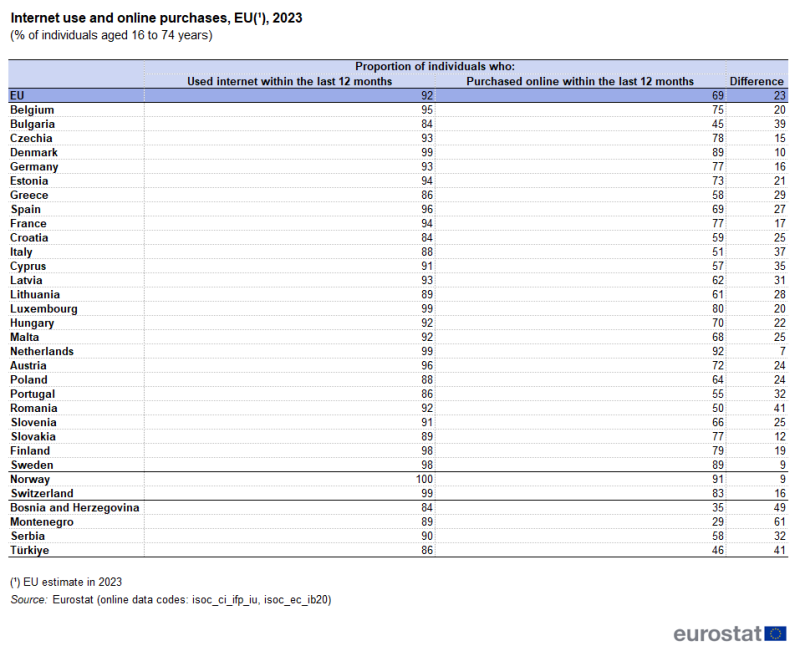
Source: Eurostat (isoc_ci_ifp_iu) and (isoc_ec_ib20)
75 % of internet users bought or ordered goods or services online in the EU in 2023
Using as a denominator the total number of individuals who used the internet in the last three months before the survey, the proportion of e-shoppers reached 75 % in 2023, from 57 % in 2013. The highest shares of online customers were declared in 2023 by the Netherlands (93 %), Sweden (91 %) and Denmark (90 %). The lowest shares were reported by Italy (58 %), Romania (55 %) and Bulgaria (54 %). From 2013 to 2023, the highest increase of the share of online shoppers were reported by Estonia (49 pp), from 29 % in 2013 to 78 % in 2023. While the EU as whole recorded an increase of 18 pp between 2013 and 2023, in the following countries, the growth was over (30 %): Romania (40 %), Hungary (37 %), Czechia (36 %), Croatia (32 %), Lithuania (32 %), Bulgaria (32 %) and Slovakia (31 %). The growth between 2013 and 2023 was particularly low in Germany (3 %), in Luxembourg (6 %) and in Malta (8 %). E-commerce was boosted by the Covid-19 pandemic in 2020 and 2021, however, in some Member States, the shares of e-shoppers in 2023 were below the levels reached in 2021 at the end of the Covid-19 pandemic. It was the case in Sweden, Denmark, Finland, Luxembourg, Belgium, Slovenia, Latvia, Greece, and Italy. In 2023, the shares of online customers were with 91 % in Norway and 84 % in Switzerland over the EU average of 75 %, while they were below the EU average in Serbia (64 %), Türkiye (53 %) and Montenegro (32 %).
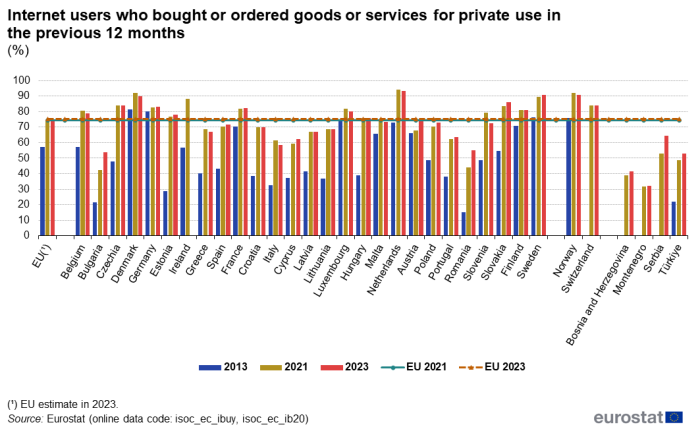
Source: Eurostat (isoc_ec_ibuy) and (isoc_ec_ib20)
E-shopping: A generational divide between e-shoppers
Since 2015, among online customers, a clear generational divide can be observed between age groups. The shares of the age groups 16-24 years, 25-34 years and 35-44 years were over the EU average while the age groups 55-64 years and 65-74 years were below the average. In 2023, 87 % of the individuals aged 25-34 years, who used the internet in the 12 months prior to the survey, bought or ordered goods or services on the internet for their personal needs. This is an increase of 1 pp compared with 2021 in which e-shopping was particularly boosted by the Covid-19 pandemic lockdowns. The proportion of the 35-44 years age group followed with a rate of 84 %, an increase of 2 pp compared with 2021. In 2023, 82 % of the individuals aged 16-24 years bought or ordered goods or services, a growth of 1 pp compared with 2021; whilst the individuals aged 45-54 years were at 75 % in 2023, a share equal to the EU average in 2023 and 1 pp over the proportion of e-shoppers of this age group in 2021. The share of the two remaining older age groups (55-64 years and 65-74 years) were below the EU average with 65 % and 60 %, respectively, in 2023(Figure 2).
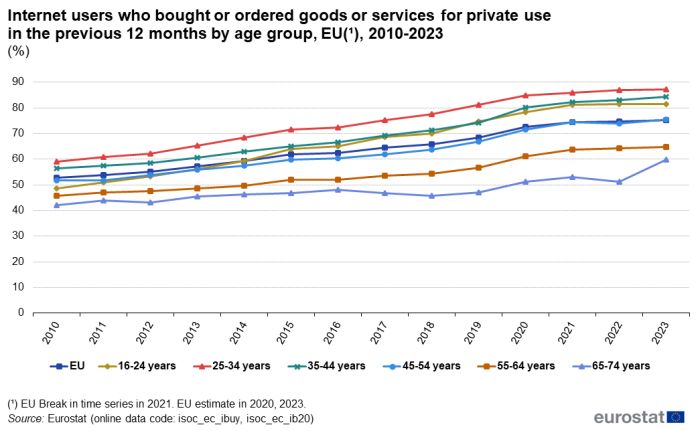
Source: Eurostat (isoc_ec_ibuy) and (isoc_ec_ib20)
In 2023, the profile of the online shoppers was closely related to their economic status. While there was almost no gender difference between e-shoppers, the level of education and the economic status were factors of differentiation. In 2023, the share of e-shoppers with no or low formal education background was 57 % compared with 75 % for the e-customers with medium formal education and up to 88 % for those with high formal education background. Regarding the employment status, 57 % of the pensioners were e-shoppers in 2023 compared with 64 % for the unemployed, 81 % for the students and 82 % for the 'employees, self-employed and family workers'. Another dichotomy was also possible depending on the place of residence. The individuals living in rural areas and those living in towns and suburbs were 73 % and 74 % respectively to order or buy goods or services in 2023 compared with 78 % for those living in cities. Nationality led to differences in e-commerce. While the nationals were at 76 % having bought or ordered goods and services online in 2023, the shares slightly dropped to 75 % for the nationals of another EU Member State and to 64 % for the nationals of non-EU countries.
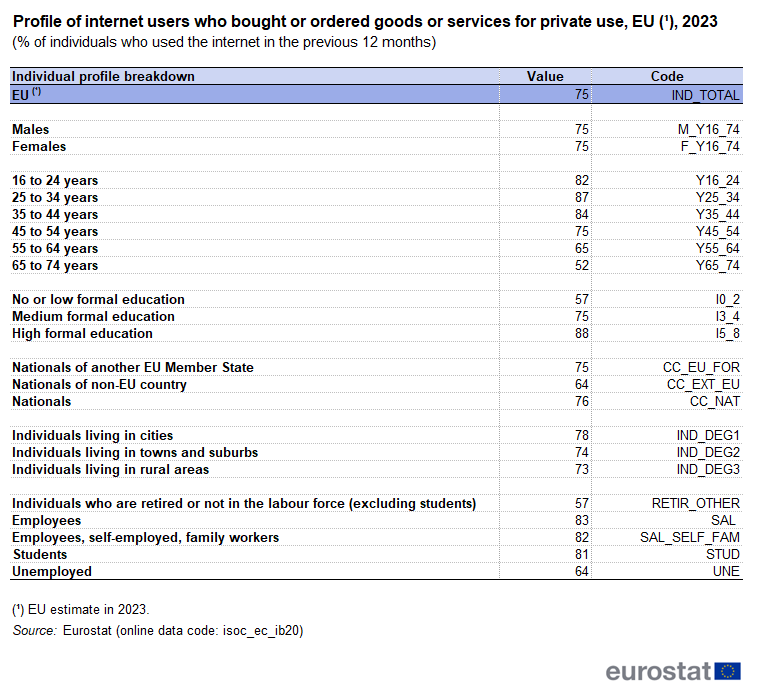
Source: Eurostat (isoc_ec_ib20)
Clothes and deliveries from restaurants on top of the online purchases in 2023
In 2023, 44 % of online shoppers bought or ordered 'clothes (including sportswear), shoes and accessories', up from 42 % in 2022. The second most popular item purchased by the online customers in 2023 was products from 'restaurants, fast-food or catering services' (19 % in the EU as a whole). The 'cosmetic and beauty products' was the third most purchased item with a rate of 18 % of the EU online shoppers in 2023. 'Clothes, shoes and accessories' were particularly bought or ordered by the 16-24 years (53 %) and the 25-34 years(57 %) age groups. The first three items ordered or bought by the age group 35-44 years were 'clothes', 'children's toys or childcare items', 'deliveries from restaurant' and 'cosmetic and beauty products'. For the age group 45-54 years, the items mostly ordered or bought were 'clothes', 'cosmetics' and 'furniture, home accessories or gardening products'. The demand of the two remaining age groups (55-64 years and 65-74 years) was similar with 'furniture and home accessories product' coming after the 'clothes' and followed by 'medicine or dietary supplements such as vitamins'.
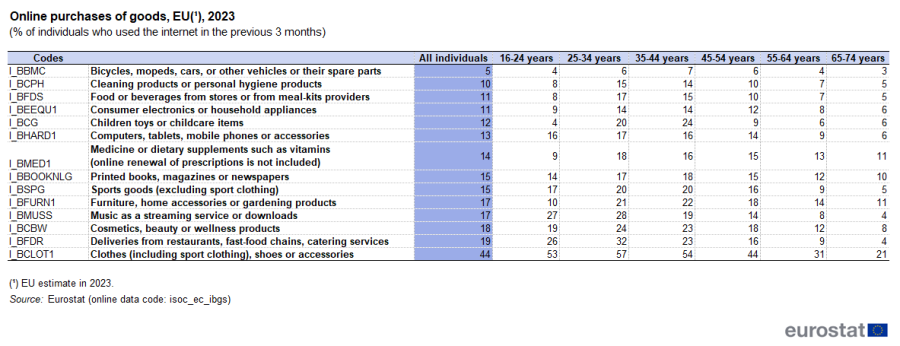
Source: Eurostat (isoc_ec_ibgs)
Frequency of the purchases: Most often 'once or twice' and 'three to five times'
How many times did e-shoppers buy or order goods or services over the internet in 2023? 21 % of the e-shoppers did it 'one or two times' in the last 3 months prior to the survey, the same proportion for those who did it 'three to five times'. For the higher frequencies 'six to ten times' and 'more than 10 times' the rates were 9 % respectively 8 % in 2023 in the EU as a whole. For the 16-24 years age group, 24 % made their purchases 'once or twice' and 24 % 'three to five' times in the 3 months preceding the survey. For the age group 25–34 years, 24 % made three to five online purchases during the period considered. 16 % of this age group had made more than ten purchases in the last 3 months prior to the survey, the highest rate for this frequency of online purchases. The frequencies of the 35–44 years age group were similar: highest proportion was for 'three to five purchases' and a relatively high rate for those who made more than ten purchases. For the remaining two age classes 55-64 years and 65-74 years, the highest proportion of individuals made one or two purchases on the internet in the 3 months preceding the survey.
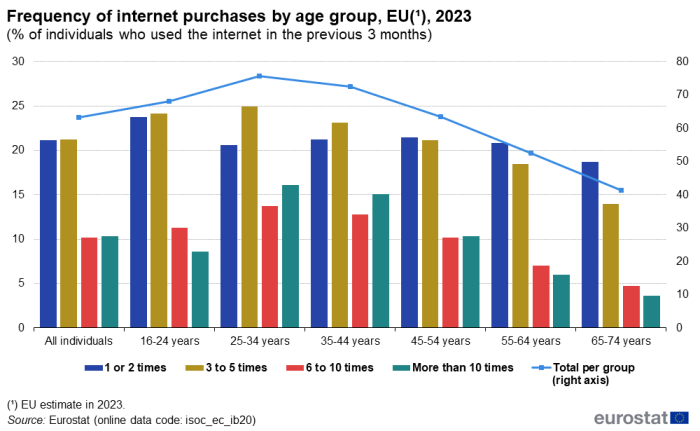
Source: Eurostat (isoc_ec_ib20)
Origin of the sellers: 53 % of the purchases made from national sellers
In 2023, the distribution of the purchases according to the origin of the sellers was the following in the EU. In the last 3 months preceding the survey, 53 % of the e-shoppers bought or ordered goods and services from a domestic seller; 21 % from a seller from other EU countries; 13 % from a seller from the rest of world and 10 % from a seller from an unknown country.
The share of males having bought or ordered goods and services from a seller from another EU country was slightly over the rate of females (21 % compared with 20 %).
In 2023, individuals aged 25-34 years presented the highest rate of individuals (64 %) with purchases from national sellers. The individuals aged 35-44 years followed with 62 %, while those aged 65-74 years were lowest with a rate of 35 % of e-shoppers in 2023. The 25-34 years and 35-44 years age groups presented the highest rates of e-customers for sellers from another EU country. The highest proportion of e-customers for sellers from non-EU countries were the age groups 16-24 years and 25-34 years. The proportion of individuals with a high formal educational background were by far the highest to have bought or ordered goods and services from a national seller in 2023 (68 % compared with 51 % and 34 % for e-shoppers with medium formal education and no or low formal education background respectively). Concerning the employment status, the share of 'employees, self-employed and family workers' having bought or ordered goods from a national seller in 2023 was 59 % compared with 51 % for students and 41 % for unemployed. Students presented in 2023 the highest share of e-shoppers for sellers from a non-EU country and from an unknown country.
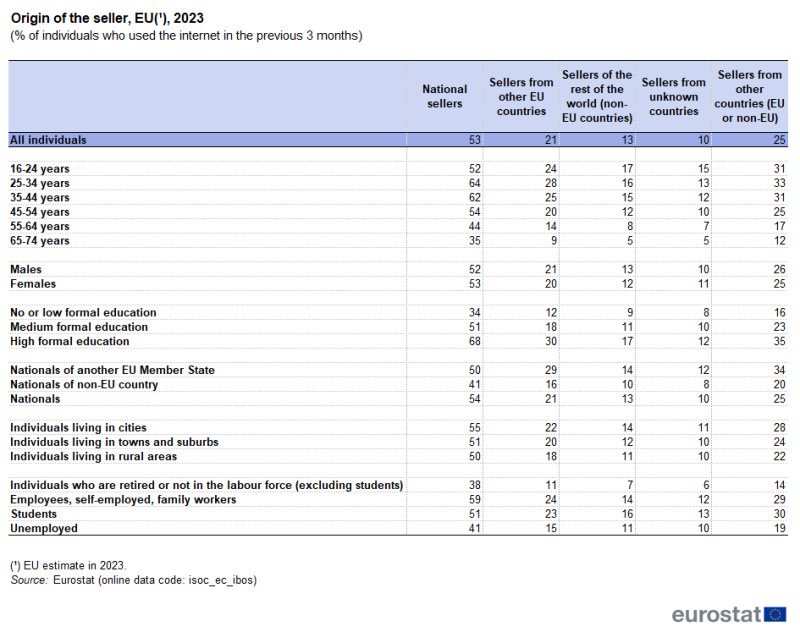
Source: Eurostat (isoc_ec_ibos)
Purchasing online and problems encountered: 42 % of e-shoppers reported having encountered no problem when purchasing online
42 % of the e-shoppers reported no issue while purchasing online compared with 21 % who encountered problems. The 'speed delivery slower than expected' was the most often issue reported (12 %). 7 % reported issues related to the 'website either difficult to use or worked unsatisfactorily'. For some 5 %, it was 'a wrong or a damaged good that has been delivered'. 4 % complained about the 'difficulty to find the information about the guarantee or other legal rights'. Some 2 % reported issues related to fraud, 'costs higher than indicated or that 'the foreign retailer did not send to the country of the respondent'.
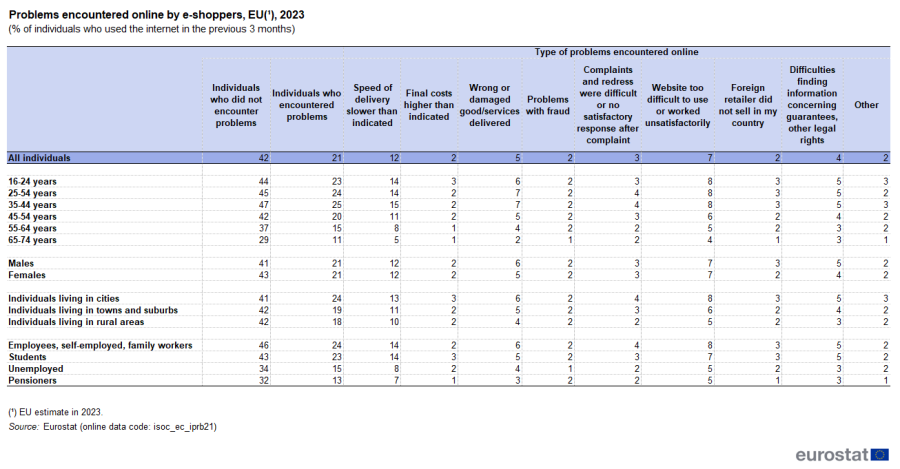
Source: Eurostat (isoc_ec_iprb21)
Collaborative economy: Purchase of physical goods above the demand for services
The collaborative economy, also known as the sharing economy, has opened up a new way of exchanging goods and services through information and communication technologies. The concept of the collaborative economy is based on the exchange, sharing and collaboration between individuals of goods, services, or knowledge with or without monetary exchange through digital platforms. In 2023, data was collected concerning transport services, rented accommodation and the exchange of physical goods.
For the EU as a whole, the flow of the collaborative economy was mainly determined by the exchange of physical goods (22 % of EU e-customers) followed by the rent of accommodation (8 % of the EU e-customers) and the transport service (2 % of e-customers).
In 2023, in the EU, it was the demand of the age groups 25-34 years and 35-44 years that sustained the exchange of physical goods with the proportion of e-shoppers of 30 % and 31 % respectively. The age group 65-74 years had low demand with only 9 % of the individuals having exchanged online physical goods in 2023.
A propensity to buy or order online from a private person seems to be positively correlated with the level of formal education on the one hand and with the employment status on the other hand. The proportion of e-shoppers of physical goods from a private seller with high formal education background was 30 % in 2023 compared with 21 % and 14 % for those with medium and no or low formal education respectively. In 2023, 26 % of 'employees, self-employed and family workers' bought physical goods from a private seller compared with 18 % of unemployed or 13 % for the pensioners.
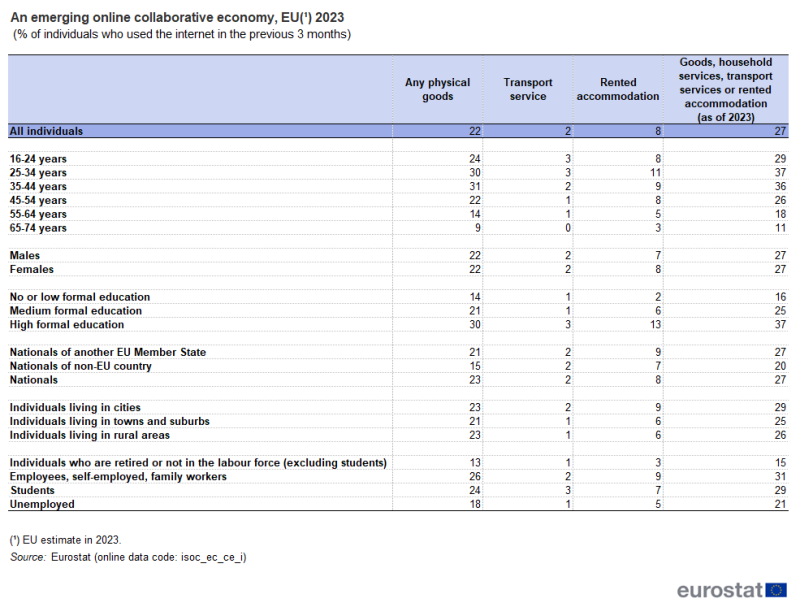
Source: Eurostat (isoc_ec_ce_i)
Data sources
The data in this article are based on the results of annual surveys on ICT usage in households and by individuals. Data were aggregated from micro data transmitted by all EU Member States and some non-EU countries (Iceland, Norway, Switzerland, Montenegro, North Macedonia, Serbia, Türkiye, Kosovo[1] and Bosnia and Herzegovina). Researchers can apply for access to the micro data.
The 2023 survey results are based on responses from a total of 150285 households in the EU having at least one person aged 16-74, and 190594 individuals in the EU aged 16-74. Individuals were asked about the last time they used the internet, how often they used it, internet activities, certain aspects of the collaborative economy, activities related to e-government, e-commerce and about privacy and protection of data together with digital skills. An e-shopper is defined as an individual who bought or ordered goods or services on-line during the last 3 months or the last 12 months prior to the survey.
Most countries collected data in the first half of 2023. The results above refer to individuals' experiences during the last 3 months or 12 months prior to the survey.
Levels of education are defined according to ISCED-2011 as follows: high (tertiary, ISCED 5, 6, 7 or 8); medium (upper secondary and post-secondary non-tertiary, ISCED 3 or 4); low (at most lower secondary, ISCED 0, 1 or 2).
Source data for tables and graphs
Context
Data from this survey supports measuring the implementation of one of the six priorities for the period 2019-2024 of the von der Leyen European Commission – A Europe fit for the digital age. The strategy is built on three pillars: (1) Technology that works for the people; (2) A fair and competitive digital economy; (3) An open, democratic and sustainable society. Furthermore, it facilitates the monitoring of the EU's digital targets for 2030, set by the EU's Digital Decade Policy Program, evolving around four cardinal points: skills, digital transformation of businesses, secure and sustainable digital infrastructures, and digitalisation of public services. Data on the use of ICT in households and by individuals appears as well among the monitoring indicators of the Consumer Conditions Scoreboard and the European Skills Agenda.
Other links:
- A Digital Single Market Strategy for Europe COM(2015) 192 final
Direct access to
Main tables
Database
Dedicated section
Data visualisations
Methodology / Metadata
Legislation
External links
Notes
- ↑ This designation is without prejudice to positions on status and is in line with UNSCR 1244 and the ICJ Opinion on the Kosovo Declaration of Independence.